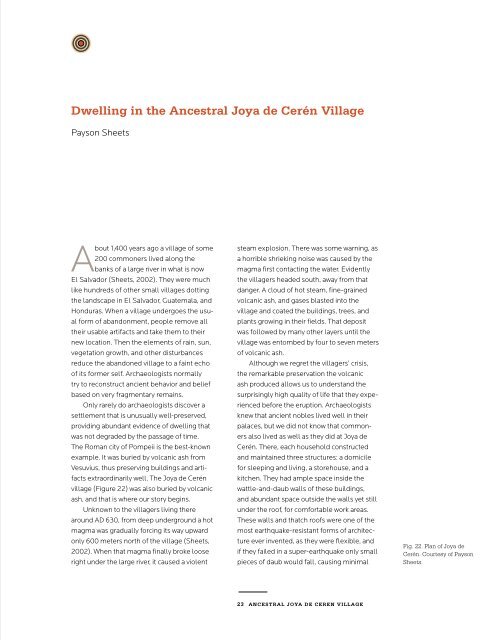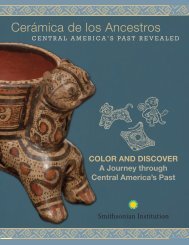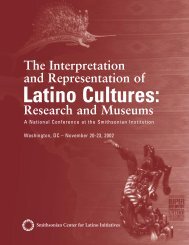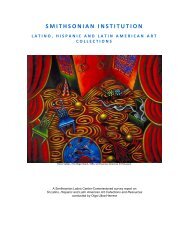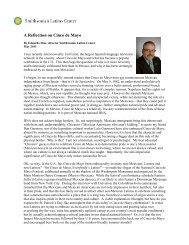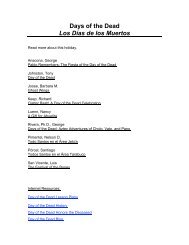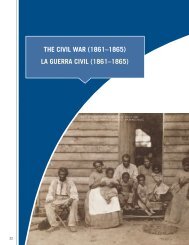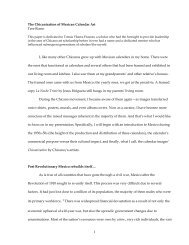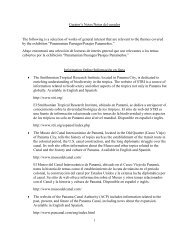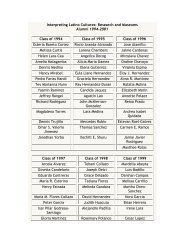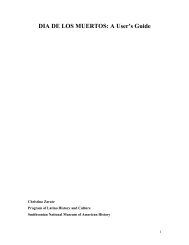Revealing Ancestral Central America - Smithsonian Latino Center ...
Revealing Ancestral Central America - Smithsonian Latino Center ...
Revealing Ancestral Central America - Smithsonian Latino Center ...
You also want an ePaper? Increase the reach of your titles
YUMPU automatically turns print PDFs into web optimized ePapers that Google loves.
Dwelling in the <strong>Ancestral</strong> Joya de Cerén Village<br />
Payson Sheets<br />
About 1,400 years ago a village of some<br />
200 commoners lived along the<br />
banks of a large river in what is now<br />
El Salvador (Sheets, 2002). They were much<br />
like hundreds of other small villages dotting<br />
the landscape in El Salvador, Guatemala, and<br />
Honduras. When a village undergoes the usual<br />
form of abandonment, people remove all<br />
their usable artifacts and take them to their<br />
new location. Then the elements of rain, sun,<br />
vegetation growth, and other disturbances<br />
reduce the abandoned village to a faint echo<br />
of its former self. Archaeologists normally<br />
try to reconstruct ancient behavior and belief<br />
based on very fragmentary remains.<br />
Only rarely do archaeologists discover a<br />
settlement that is unusually well-preserved,<br />
providing abundant evidence of dwelling that<br />
was not degraded by the passage of time.<br />
The Roman city of Pompeii is the best-known<br />
example. It was buried by volcanic ash from<br />
Vesuvius, thus preserving buildings and artifacts<br />
extraordinarily well. The Joya de Cerén<br />
village (Figure 22) was also buried by volcanic<br />
ash, and that is where our story begins.<br />
Unknown to the villagers living there<br />
around AD 630, from deep underground a hot<br />
magma was gradually forcing its way upward<br />
only 600 meters north of the village (Sheets,<br />
2002). When that magma finally broke loose<br />
right under the large river, it caused a violent<br />
steam explosion. There was some warning, as<br />
a horrible shrieking noise was caused by the<br />
magma first contacting the water. Evidently<br />
the villagers headed south, away from that<br />
danger. A cloud of hot steam, fine-grained<br />
volcanic ash, and gases blasted into the<br />
village and coated the buildings, trees, and<br />
plants growing in their fields. That deposit<br />
was followed by many other layers until the<br />
village was entombed by four to seven meters<br />
of volcanic ash.<br />
Although we regret the villagers’ crisis,<br />
the remarkable preservation the volcanic<br />
ash produced allows us to understand the<br />
surprisingly high quality of life that they experienced<br />
before the eruption. Archaeologists<br />
knew that ancient nobles lived well in their<br />
palaces, but we did not know that commoners<br />
also lived as well as they did at Joya de<br />
Cerén. There, each household constructed<br />
and maintained three structures: a domicile<br />
for sleeping and living, a storehouse, and a<br />
kitchen. They had ample space inside the<br />
wattle-and-daub walls of these buildings,<br />
and abundant space outside the walls yet still<br />
under the roof, for comfortable work areas.<br />
These walls and thatch roofs were one of the<br />
most earthquake-resistant forms of architecture<br />
ever invented, as they were flexible, and<br />
if they failed in a super-earthquake only small<br />
pieces of daub would fall, causing minimal<br />
Fig. 22. Plan of Joya de<br />
Cerén. Courtesy of Payson<br />
Sheets.<br />
23 ANCESTRAL JOYA DE CEREN VILLAGE


